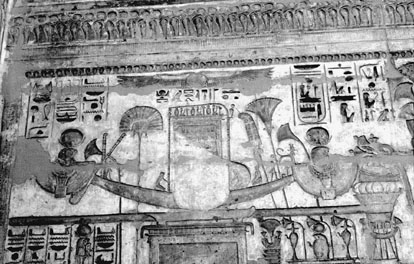

 | Page 446 |  |
Diospolis Parva. He was therefore able to create a relative chronology for the predynastic period, which was later to be broadly confirmed both by stratigraphic excavation and by radiocarbon dating.

Wall relief showing royal barge at the temple of Rameses III at Medinet Habu
(Ann Ronan Picture Library)
Although George Reisner did not begin to excavate in Egypt until about twenty years after the arrival of Petrie, he nevertheless had a comparable impact on the field. Like Petrie, Reisner paid an enormous attention to detail, but he was also the first archaeologist in Egypt to recognize the need to provide such detailed records of his surveys or excavations that any future researcher would be able to reconstruct both the site and the process by which it was originally examined. At the predynastic cemetery of Naga ed-Der, for instance, the records of his excavations of 1901 have proved an invaluable resource to modern anthropologists and prehistorians (see Podzorski 1990). According to a description of Reisner’s methods of work, every object found was visually recorded at the time, and as objects were removed from the ground, they were again photographed, sometimes from several angles, and every single object or fragment, potsherd, bead, scrap of every kind as well as important objects was entered in a register with an identifying number, a careful verbal description, usually a measured drawing, measurements, date, place of finding, and a note of photographs taken. The principal drawback of Reisner’s painstaking approach was the inherent slowness of preparing the reports for publication, which meant that much of his work was still unpublished at his death.
It was Reisner who introduced the systematic use of section drawing into Egyptian archaeology, some forty years after such stratigraphic analysis had been pioneered by Giuseppe Fiorelli at pompeii. All previous excavators in Egypt had simply used plans to describe the various stages of excavation at a site, and although Petrie had drawn profiles of the stratigraphy at the Palestinian site of Tell el Hesy in 1890, Reisner was the first to record the stratigraphy of ancient Egyptian sites. He was also one of the earliest archaeologists to take genuinely multidisciplinary teams to Egypt. At Naga ed-Der he was accompanied by the anatomist sir grafton elliot smith, whose detailed observations on the material
 |  |